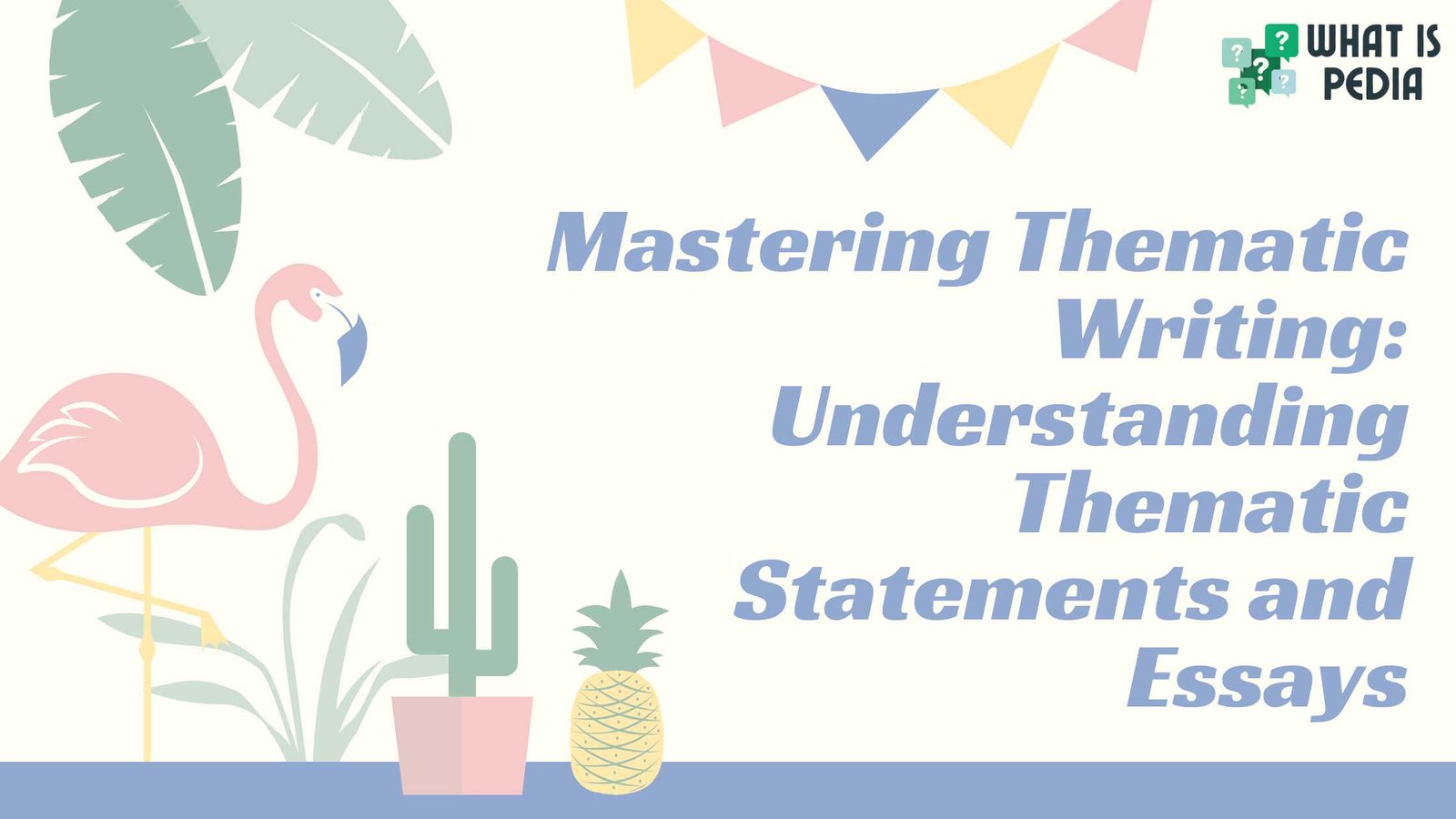Introduction:
A thematic statement is a concise expression of the central message or insight found within a literary work. It goes beyond summarizing the plot by conveying a deeper universal truth that the story explores. For example, rather than stating, “This novel is about war,” a thematic statement might say, “War dehumanizes individuals and erodes moral values.”
Thematic Statement Definition
A thematic statement is a sentence that captures the essence of a theme—an idea, concept, or lesson—that a piece of literature communicates. Unlike a topic, which is a subject like love, death, or freedom, a theme conveys what the author says about that subject. The thematic statement is analytical and interpretative, requiring readers to infer and synthesize information.
What are Thematic Statements and Why Are They Important?
Thematic statements are important because they:
- Guide the interpretation of literature.
- Provide a unifying focus for literary analysis essays.
- Help readers connect the story to broader human experiences.
They allow us to understand what the author is saying about life, society, or human nature and encourage critical thinking beyond the text.
What’s a Thematic Statement? (Alternate Interpretations)
Thematic statements can vary depending on readers’ interpretations. For instance, one reader might see the theme of The Great Gatsby as “The American Dream is an illusion,” while another might interpret it as “Materialism leads to spiritual emptiness.” Both are valid as long as they are supported by textual evidence.
How to Write a Thematic Statement
Writing a strong thematic statement involves several steps:
- Identify the central topics (e.g., love, justice, betrayal).
- Observe how the author treats those topics through characters, conflicts, and outcomes.
- Synthesize your observations into a universal message.
- Write a complete sentence that expresses this message.
Example:
- Topic: Freedom
- Thematic Statement: “True freedom comes from within, not from external circumstances.”
Theme Stated Examples in Literature
- To Kill a Mockingbird by Harper Lee: “Justice is not always served in a prejudiced society.”
- Romeo and Juliet by William Shakespeare: “Unchecked passion can lead to tragic consequences.”
- The Catcher in the Rye by J.D. Salinger: “The struggle to preserve innocence is both noble and futile.”
These examples show how a thematic statement reflects the deeper meaning conveyed through the plot and characters.
Thematic Statement vs. Thesis Statement
While both are analytical tools, they serve different purposes:
- Thematic Statement: An insight or message about life found in literature.
- Thesis Statement: The main argument or claim in an essay, often incorporating a thematic statement if the essay analyzes literature.
Example:
- Thematic: “Greed leads to self-destruction.”
- Thesis: “In Macbeth, Shakespeare illustrates that unchecked ambition and greed inevitably lead to one’s downfall, as seen in Macbeth’s tragic end.”
Essay on a Theme: Understanding Theme in Writing
An essay on a theme explores the central idea of a literary work and how it’s developed. It involves:
- Stating the theme
- Supporting it with textual evidence
- Analyzing literary elements like setting, plot, and character development
This type of essay requires thoughtful interpretation and a clear argument that ties together evidence from the text.
Thematic Essay: Structure and Purpose
A thematic essay follows a structured format:
- Introduction: Introduces the theme and your interpretation.
- Body Paragraphs: Each paragraph provides evidence and analysis to support the thematic statement.
- Conclusion: Summarizes the insights and reinforces the theme’s significance.
The purpose is to explore how a theme is developed throughout a work and what it reveals about the human condition.
How to Write a Thematic Essay
- Choose a theme that resonates with the literary work.
- Craft a thematic statement that conveys a universal insight.
- Develop a thesis that includes your thematic statement.
- Use quotes and examples from the text to support your points.
- Analyze the author’s use of literary devices such as symbolism, characterization, and plot.
Thematic Essay Example: A Step-by-Step Analysis
Literary Work: Of Mice and Men by John Steinbeck
Theme: Loneliness and the human need for companionship
Thematic Statement: “Loneliness is a fundamental part of the human experience, and the search for companionship is a basic human need.”
Thesis Statement: In Of Mice and Men, Steinbeck demonstrates how pervasive loneliness can lead to despair and how the desire for connection motivates the characters’ actions.
Body Paragraph Example:
- Topic Sentence: George and Lennie’s relationship illustrates the deep human desire to avoid loneliness.
- Evidence: George says, “Guys like us… are the loneliest guys in the world.”
- Analysis: This highlights the rarity and importance of their bond in a harsh world.
Tips for Crafting an Essay on Theme
- Avoid moralizing: Thematic statements are not judgments but observations.
- Use specific evidence: Always support your interpretation with quotes.
- Focus on universal ideas: Your thematic statement should apply broadly.
- Be concise: A good thematic statement is clear and to the point.
- Revise for clarity: Make sure your theme is well-expressed and logically supported.
Conclusion: Mastering Thematic Writing
Understanding what a thematic statement is and how to construct one is essential for literary analysis. Whether you’re writing a thematic essay or simply trying to comprehend a novel’s deeper meaning, thematic statements provide a focused lens through which to view literature. By analyzing themes, supporting them with evidence, and interpreting their broader significance, you not only improve your writing skills but also deepen your appreciation of literature and the human experiences it reflects.
With practice, you’ll be able to craft insightful thematic statements and essays that resonate with readers and demonstrate a sophisticated understanding of literary texts.







